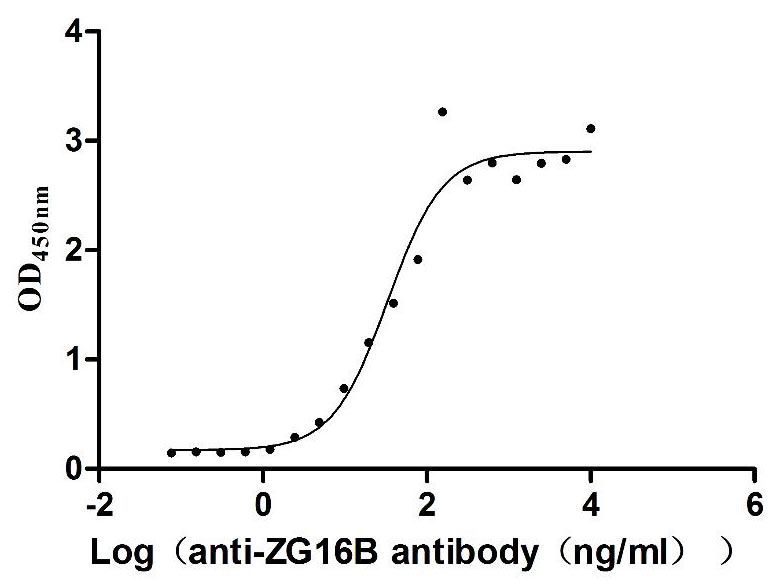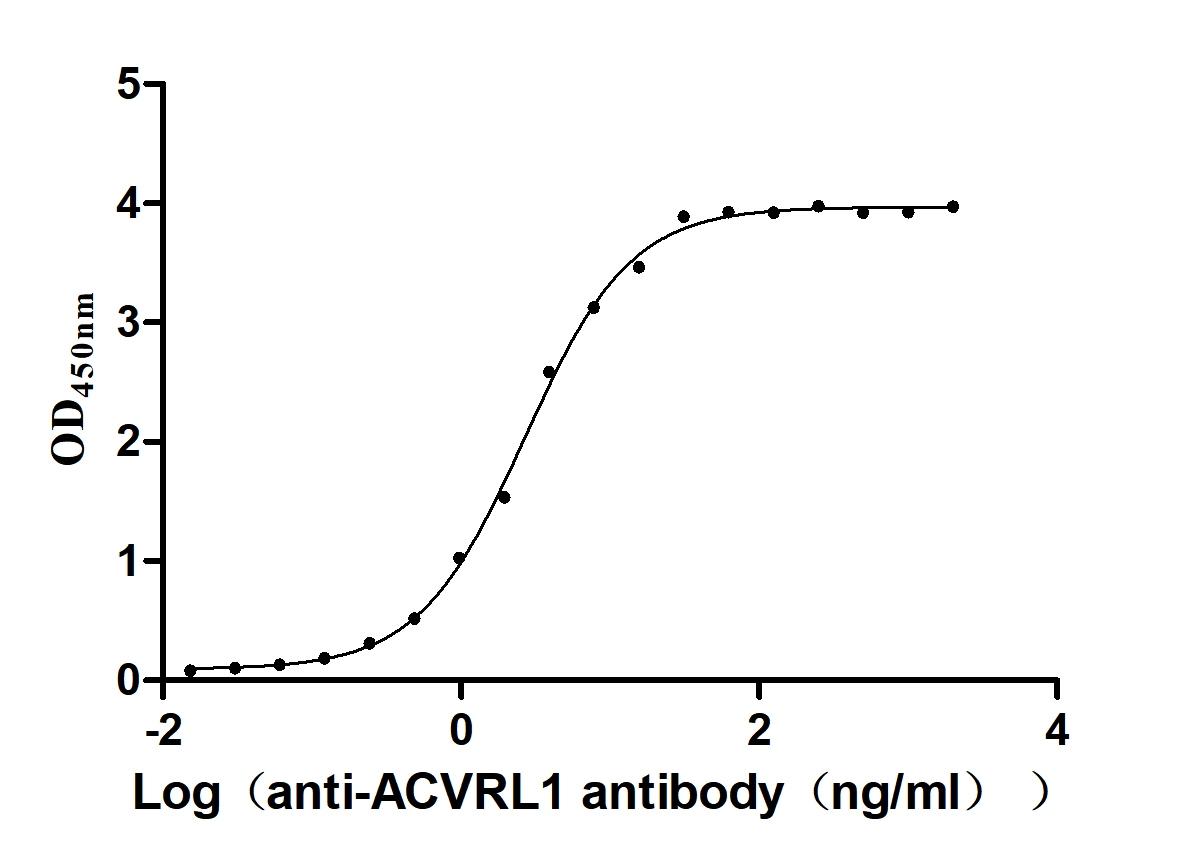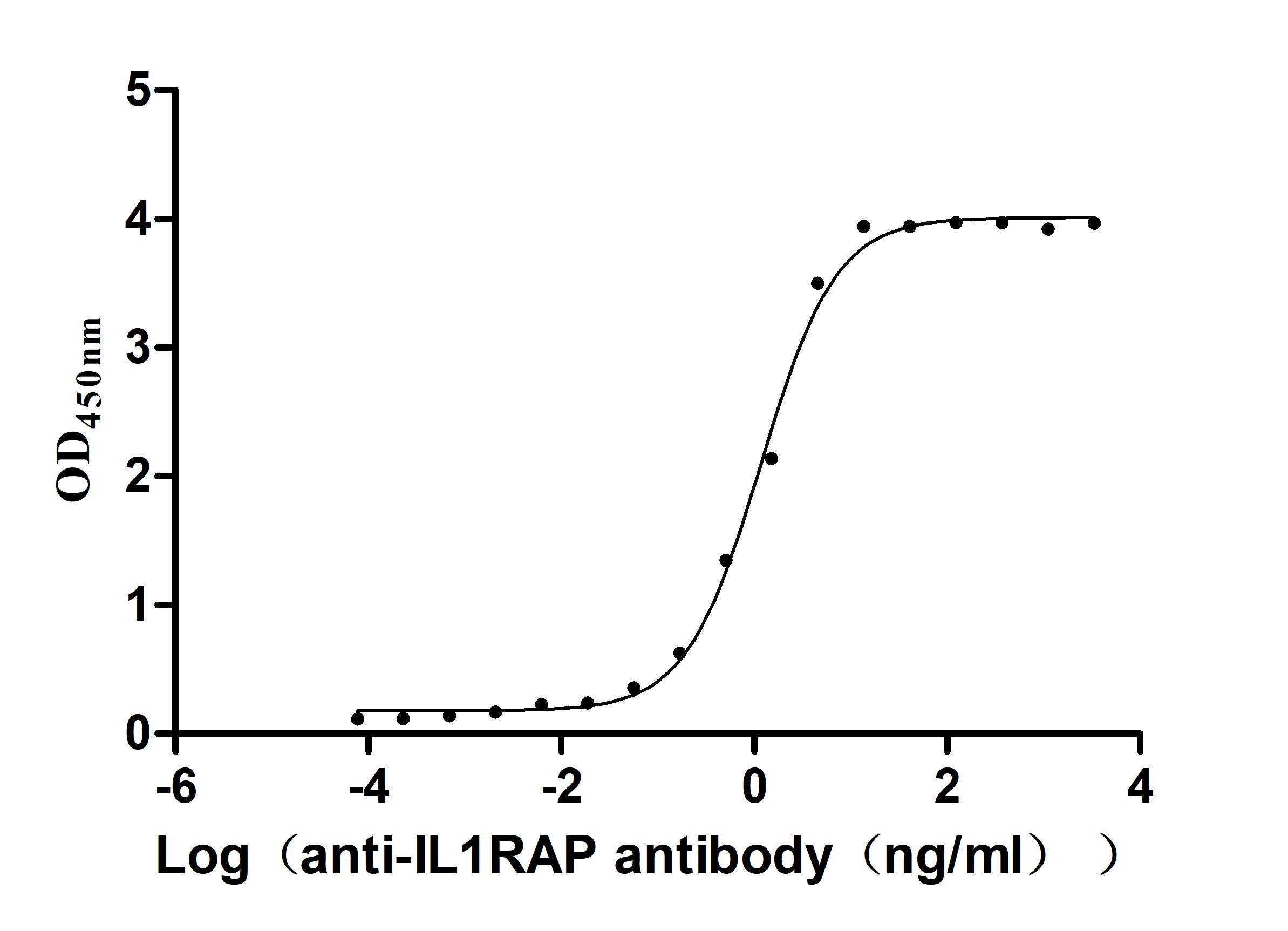Recombinant Human Protein kinase C beta type (PRKCB)
-
中文名稱:人PRKCB重組蛋白
-
貨號(hào):CSB-YP018700HU
-
規(guī)格:
-
來(lái)源:Yeast
-
其他:
-
中文名稱:人PRKCB重組蛋白
-
貨號(hào):CSB-EP018700HU
-
規(guī)格:
-
來(lái)源:E.coli
-
其他:
-
中文名稱:人PRKCB重組蛋白
-
貨號(hào):CSB-EP018700HU-B
-
規(guī)格:
-
來(lái)源:E.coli
-
共軛:Avi-tag Biotinylated
E. coli biotin ligase (BirA) is highly specific in covalently attaching biotin to the 15 amino acid AviTag peptide. This recombinant protein was biotinylated in vivo by AviTag-BirA technology, which method is BriA catalyzes amide linkage between the biotin and the specific lysine of the AviTag.
-
其他:
-
中文名稱:人PRKCB重組蛋白
-
貨號(hào):CSB-BP018700HU
-
規(guī)格:
-
來(lái)源:Baculovirus
-
其他:
-
中文名稱:人PRKCB重組蛋白
-
貨號(hào):CSB-MP018700HU
-
規(guī)格:
-
來(lái)源:Mammalian cell
-
其他:
產(chǎn)品詳情
-
純度:>85% (SDS-PAGE)
-
基因名:
-
Uniprot No.:
-
別名:KPCB_HUMAN; PKC Beta; PKC-B; PKC-beta; PKCB; Prkcb; PRKCB II; PRKCB2; Protein kinase C beta; Protein kinase C beta type
-
種屬:Homo sapiens (Human)
-
蛋白長(zhǎng)度:Full Length of Mature Protein
-
表達(dá)區(qū)域:2-671
-
氨基酸序列ADPAAGPPP SEGEESTVRF ARKGALRQKN VHEVKNHKFT ARFFKQPTFC SHCTDFIWGF GKQGFQCQVC CFVVHKRCHE FVTFSCPGAD KGPASDDPRS KHKFKIHTYS SPTFCDHCGS LLYGLIHQGM KCDTCMMNVH KRCVMNVPSL CGTDHTERRG RIYIQAHIDR DVLIVLVRDA KNLVPMDPNG LSDPYVKLKL IPDPKSESKQ KTKTIKCSLN PEWNETFRFQ LKESDKDRRL SVEIWDWDLT SRNDFMGSLS FGISELQKAS VDGWFKLLSQ EEGEYFNVPV PPEGSEANEE LRQKFERAKI SQGTKVPEEK TTNTVSKFDN NGNRDRMKLT DFNFLMVLGK GSFGKVMLSE RKGTDELYAV KILKKDVVIQ DDDVECTMVE KRVLALPGKP PFLTQLHSCF QTMDRLYFVM EYVNGGDLMY HIQQVGRFKE PHAVFYAAEI AIGLFFLQSK GIIYRDLKLD NVMLDSEGHI KIADFGMCKE NIWDGVTTKT FCGTPDYIAP EIIAYQPYGK SVDWWAFGVL LYEMLAGQAP FEGEDEDELF QSIMEHNVAY PKSMSKEAVA ICKGLMTKHP GKRLGCGPEG ERDIKEHAFF RYIDWEKLER KEIQPPYKPK ARDKRDTSNF DKEFTRQPVE LTPTDKLFIM NLDQNEFAGF SYTNPEFVIN V
-
蛋白標(biāo)簽:Tag?type?will?be?determined?during?the?manufacturing?process.
The tag type will be determined during production process. If you have specified tag type, please tell us and we will develop the specified tag preferentially. -
產(chǎn)品提供形式:Lyophilized powder
Note: We will preferentially ship the format that we have in stock, however, if you have any special requirement for the format, please remark your requirement when placing the order, we will prepare according to your demand. -
復(fù)溶:We recommend that this vial be briefly centrifuged prior to opening to bring the contents to the bottom. Please reconstitute protein in deionized sterile water to a concentration of 0.1-1.0 mg/mL.We recommend to add 5-50% of glycerol (final concentration) and aliquot for long-term storage at -20℃/-80℃. Our default final concentration of glycerol is 50%. Customers could use it as reference.
-
儲(chǔ)存條件:Store at -20°C/-80°C upon receipt, aliquoting is necessary for mutiple use. Avoid repeated freeze-thaw cycles.
-
保質(zhì)期:The shelf life is related to many factors, storage state, buffer ingredients, storage temperature and the stability of the protein itself.
Generally, the shelf life of liquid form is 6 months at -20°C/-80°C. The shelf life of lyophilized form is 12 months at -20°C/-80°C. -
貨期:Delivery time may differ from different purchasing way or location, please kindly consult your local distributors for specific delivery time.Note: All of our proteins are default shipped with normal blue ice packs, if you request to ship with dry ice, please communicate with us in advance and extra fees will be charged.
-
注意事項(xiàng):Repeated freezing and thawing is not recommended. Store working aliquots at 4°C for up to one week.
-
Datasheet :Please contact us to get it.
相關(guān)產(chǎn)品
靶點(diǎn)詳情
-
功能:Calcium-activated, phospholipid- and diacylglycerol (DAG)-dependent serine/threonine-protein kinase involved in various cellular processes such as regulation of the B-cell receptor (BCR) signalosome, oxidative stress-induced apoptosis, androgen receptor-dependent transcription regulation, insulin signaling and endothelial cells proliferation. Plays a key role in B-cell activation by regulating BCR-induced NF-kappa-B activation. Mediates the activation of the canonical NF-kappa-B pathway (NFKB1) by direct phosphorylation of CARD11/CARMA1 at 'Ser-559', 'Ser-644' and 'Ser-652'. Phosphorylation induces CARD11/CARMA1 association with lipid rafts and recruitment of the BCL10-MALT1 complex as well as MAP3K7/TAK1, which then activates IKK complex, resulting in nuclear translocation and activation of NFKB1. Plays a direct role in the negative feedback regulation of the BCR signaling, by down-modulating BTK function via direct phosphorylation of BTK at 'Ser-180', which results in the alteration of BTK plasma membrane localization and in turn inhibition of BTK activity. Involved in apoptosis following oxidative damage: in case of oxidative conditions, specifically phosphorylates 'Ser-36' of isoform p66Shc of SHC1, leading to mitochondrial accumulation of p66Shc, where p66Shc acts as a reactive oxygen species producer. Acts as a coactivator of androgen receptor (AR)-dependent transcription, by being recruited to AR target genes and specifically mediating phosphorylation of 'Thr-6' of histone H3 (H3T6ph), a specific tag for epigenetic transcriptional activation that prevents demethylation of histone H3 'Lys-4' (H3K4me) by LSD1/KDM1A. In insulin signaling, may function downstream of IRS1 in muscle cells and mediate insulin-dependent DNA synthesis through the RAF1-MAPK/ERK signaling cascade. Participates in the regulation of glucose transport in adipocytes by negatively modulating the insulin-stimulated translocation of the glucose transporter SLC2A4/GLUT4. Phosphorylates SLC2A1/GLUT1, promoting glucose uptake by SLC2A1/GLUT1. Under high glucose in pancreatic beta-cells, is probably involved in the inhibition of the insulin gene transcription, via regulation of MYC expression. In endothelial cells, activation of PRKCB induces increased phosphorylation of RB1, increased VEGFA-induced cell proliferation, and inhibits PI3K/AKT-dependent nitric oxide synthase (NOS3/eNOS) regulation by insulin, which causes endothelial dysfunction. Also involved in triglyceride homeostasis. Phosphorylates ATF2 which promotes cooperation between ATF2 and JUN, activating transcription.
-
基因功能參考文獻(xiàn):
- Tumor suppressor activity of protein kinase C-beta.[review] PMID: 28571764
- The results demonstrate a direct relationship between SP1 binding and protein kinase CbetaII (PKCbetaII) transcription, and further suggest that this transcription factor is a contributor to the pathobiology of chronic lymphocytic leukaemia and potentially other malignant cells where PKCbetaII is overexpressed. PMID: 28233872
- An exaggerated vasoconstriction response to dexmedetomidine, an alpha-2 adrenergic agonist, has been associated with SNP rs9922316 in the gene for protein kinase C type beta ( PRKCB). PMID: 28482761
- PKC beta would sensitize cervical cancer cells to chemotherapy via reducing the chemotherapy induced autophagy in cancer cells. PMID: 28246354
- Loss of PRKCB2 expression is associated with colorectal cancer. PMID: 26989024
- significantly different gene expressions of BECN1 and PRKCB between the control and the Alzheimer's disease (AD) groups and of CDKN2A between the control and the preclinical AD groups, are reported. PMID: 26510741
- a primary functional variant of PRKCB (rs35015313) was identified by genotype imputation using a phased panel of 1,070 Japanese individuals from a prospective, general population cohort study and subsequent in vitro functional analyses. These results may lead to improved understanding of the disease pathways involved in primary biliary cholangitis. PMID: 28062665
- our findings identify PRKCB gene as a novel candidate gene for familial Meniere's Disease (MD )and its expression gradient in supporting cells of the organ of Corti deserves attention, given the role of supporting cells in K(+ )recycling within the endolymph, and its apical turn location may explain the onset of hearing loss at low frequencies in MD PMID: 27329761
- Activation of the Pro-Oxidant PKCbetaII-p66Shc Signaling Pathway Contributes to Pericyte Dysfunction in Skeletal Muscles of Patients With Diabetes With Critical Limb Ischemia PMID: 27600065
- Taken together, these data argue for a complex mechanism of PKC-beta-dependent regulation of SHCA (p66) activation involving Ser(139) and a motif surrounding Ser(213). PMID: 27624939
- The study aimed to identify a small set of genetic signatures that may reliably predict the individuals with a high genetic propensity to heroin addiction. A set of 4 genes (JUN, CEBPB, PRKCB, ENO2, or CEBPG) could predict the diagnosis of heroin addiction with the accuracy rate around 85% in our dataset. PMID: 27495086
- Bone marrow stroma-induced resistance of chronic lymphocytic leukemia cells to arsenic trioxide involves Mcl-1 upregulation and is overcome by inhibiting the PI3Kdelta or PKCbeta signaling pathways. PMID: 26540567
- PPAR-delta and NKIRAS1 are downstream mediators in the PRKCB pathway in human umbilical vein endothelial cells. PMID: 26459836
- Lower hydrogen sulfide is associated with cardiovascular mortality, which involves PKCBII/Akt pathway in chronic hemodialysis patients. PMID: 26439941
- Study found a significant decrease of PRCKB1 mRNA expression in subsyndromal symptomatic depression, suggesting PRKCB1 might be a candidate gene and biomarker PMID: 26343587
- PKCbetaII inhibits the ubiquitination of beta-arrestin2 in an autophosphorylation-dependent manner PMID: 26545496
- Ionizing radiation-induced eNOS activation in human vascular endothelial cells is attributed to both the up-regulation of PKC-betaII and the increase in ROS generation which were independent of each other. PMID: 25869503
- Effect of PKC-beta Signaling Pathway on Expression of MCP-1 and VCAM-1 in Different Cell Models in Response to Advanced Glycation End Products PMID: 26008233
- Direct interaction between the two proteins leads to Apoptin-induced activation of PKC and consequently activated PKCbetaI mediates phosphorylation of Apoptin to promote its tumour-specific nuclear translocation and cytotoxic function. PMID: 25828882
- Gene fusions involving PRKC genes occur in several morphological and clinical subsets of benign fibrous histiocytoma, but they seem to account for only a minority of the cases. PMID: 26121314
- PMA primed PBTLs for polarization under flow, with protein kinase C (PKC)-delta enriched in the leading edge, PKC-betaI in the microtubule organizing center, and PKC-betaII in the uropod and peripheral region. PMID: 25548371
- Our data indicate a new direction for LOX-1 regulation by the modulation of the PKCbeta/NAPDH oxidase/SIRT1/HSF1 mechanism PMID: 25982096
- Hyperoxia can increase the expression of PKCbeta in alveolar epithelial cells and production of mitochondrial reactive oxygen species and decrease mitochondrial membrane potential. PMID: 25815500
- human AKAP79-anchored PKC selectively phosphorylates the Robo3.1 receptor subtype on serine 1330 PMID: 25882844
- that the high-concentration glucose-induced disruption of endothelial adherens junctions is mediated by tyrosine phosphorylation of vascular endothelial cadherin through PKC-beta and myosin light chain phosphorylation PMID: 25927959
- PKCbeta2 inhibition protects mice from gut ischemia-reperfusion injury by suppressing the adaptor p66(Shc)-mediated oxidative stress and subsequent apoptosis. PMID: 24722289
- The detected PDPN-PRKCB, CD63-PRKCD and LAMTOR1-PRKCD gene fusions are all predicted to result in chimeric proteins consisting of the membrane-binding part of PDPN, CD63 or LAMTOR1 PMID: 24721208
- PRKCB2 is specifically required for mTORC2-dependent AC9 activation and back retraction during neutrophil chemotaxis. PMID: 24600048
- Pharmacological inhibition PRKCB1 via their specific inhibitors and neutralisation of O2 (*-) by a cell-permeable superoxide dismutase mimetic. PMID: 24936444
- isoform betaII plays a central role in the PKC-dependent regulation of Kv1.5/Kvbeta1.2 channels. PMID: 24682423
- shRNA knockdown of PKCbeta reduced cellular proliferation, colony formation, and migratory capacity of melanoma cells and also reduced lung colonization of stably transduced melanoma cells in mice. PMID: 24406113
- STAT3 bound to previously undescribed negative regulatory elements within the promoter of PRKCB, which encodes PKCbetaII. PMID: 24550541
- Protein kinase C beta is important for the regulation of NHE-1 activity, which is associated with ERK1/2-p90RSK signaling pathways as a kinase of NHE-1 in cortical neuronal cells exposed to glutamate. PMID: 24378530
- Vimentin is a phosphorylation target of PKC-beta in MCP-1-treated monocytes and that PKC-beta phosphorylation is essential for vimentin secretion. PMID: 23974215
- CD40L may contribute to atherogenesis via PRKCB by activating endothelial cells and recruiting monocytes to them. PMID: 24039784
- established an important role for PKCbeta1 in PANC1 cells suggesting it would act as a suppressor of tumorigenic behavior in pancreatic cancer PMID: 23695799
- Data suggest that hyperglycemia promotes cerebral-barrier dysfunction through activation of PKCbeta and consequent stimulation of oxidative stress and tight junction dissolution. PMID: 23617822
- This review summarizes the current knowledge of both PKCbeta and PKCdelta isoforms during atherogenesis, and addresses differential roles and disputable observations of PKC isoforms. PMID: 24440741
- The translocation of PKCBetaII was induced by soluble amyloid Beta precursor protein alpha. PMID: 23905995
- Normalization of glucose levels and silencing PKCB activity neutralized the effects of hyperglycemia on occludin and RhoA/Rho-kinase/MLC2 expression, localization, and activity and consequently improved in vitro blood-brain barrier integrity and function. PMID: 23963366
- HIF1alpha and PKCbeta have roles in mediating the effect of oxygen and glucose during wound healing PMID: 23562913
- PKCbeta is the isoform responsible for Syk negative regulation PMID: 23960082
- PKCalpha and PKCbeta cooperate in IL-2 transcriptional transactivation in primary mouse T cells independently of the actions of PKCtheta;. PMID: 23439007
- Protein kinase Cbeta critically regulates dopamine D2 autoreceptor-activated dopamine transporter trafficking. PMID: 23458603
- Genetic variation in protein kinase C type beta may contribute toward the interindividual variation in DHV constriction responses to alpha2-AR activation by the agonist dexmedetomidine PMID: 23337848
- PKCbeta plays an important role in Acquired immunodeficiency syndrome (AIDS)-related non-Hodgkin lymphoma survival. PMID: 21997316
- Inhibition of PKCbeta enhanced apoptosis of human autoreactive B cells. PMID: 23280626
- The expression of protein kinase C (PKC)-betaII and the subsequent activation of NF-kappaB in bone marrow stromal cells are prerequisites to support the survival of malignant B cells. PMID: 23328482
- Comp of gene expression between PROX1-overexpressing and mock-transfected cells revealed that the expression of PRKCB2 is down-regulated in PROX1-overexpressing cells. A PRKCB inhibitor suppressed growth of control cells more than PROX1-expressing cells. PMID: 22833470
- Estrogen receptor-alpha, RBCK1, and protein kinase C beta 1 cooperate to regulate estrogen receptor-alpha gene expression. PMID: 23042805
顯示更多
收起更多
-
亞細(xì)胞定位:Cytoplasm. Nucleus. Membrane; Peripheral membrane protein.
-
蛋白家族:Protein kinase superfamily, AGC Ser/Thr protein kinase family, PKC subfamily
-
數(shù)據(jù)庫(kù)鏈接:
Most popular with customers
-
Recombinant Human Zymogen granule protein 16 homolog B (ZG16B) (Active)
Express system: Mammalian cell
Species: Homo sapiens (Human)
-
Recombinant Human Serine/threonine-protein kinase receptor R3 (ACVRL1), partial (Active)
Express system: Baculovirus
Species: Homo sapiens (Human)
-
Recombinant Macaca fascicularis Zinc transporter ZIP6 isoform X1(SLC39A6),partial (Active)
Express system: Baculovirus
Species: Macaca fascicularis (Crab-eating macaque) (Cynomolgus monkey)
-
Express system: Mammalian cell
Species: Homo sapiens (Human)
-
Recombinant Human Interleukin-1 receptor accessory protein (IL1RAP), partial (Active)
Express system: Mammalian cell
Species: Homo sapiens (Human)

















